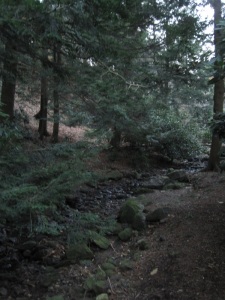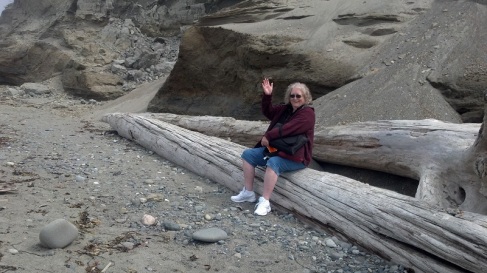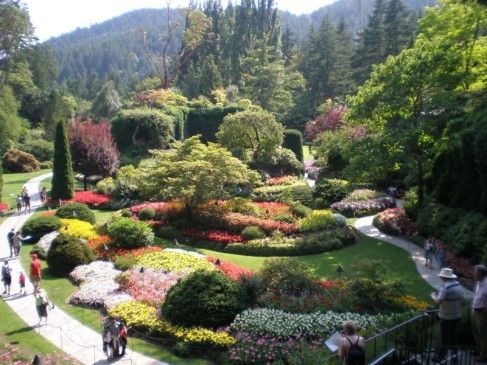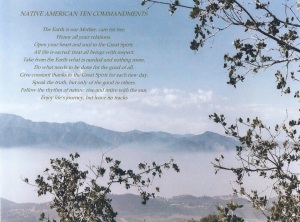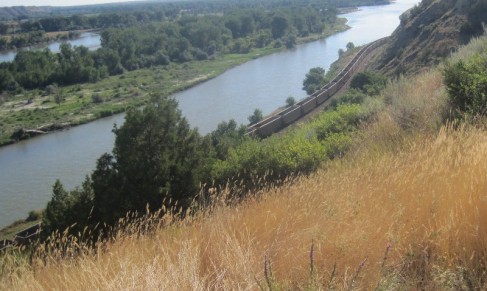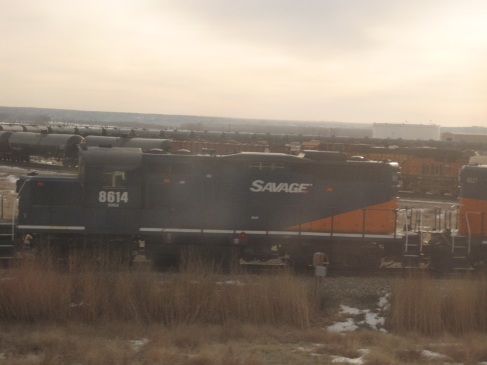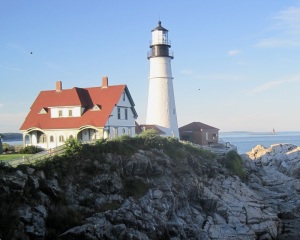Thankfuls
Thanksgiving Day in Boston visiting my son. A very good day, cooking, talking, eating. Took a walk around Jamaica Pond. Clear, bright, cold afternoon, the water a deep rich blue rippling under a steady breeze. Over dinner we said our thankfuls – something we have done for years. I’m thankful to be here, that David is doing well and Robin is having a good year. She and I said thankfuls over the phone.
Arrived in Boston November 16 after traveling across the countryon Amtrak. Beautiful trip. Snow in the mountains of western Montana coming through Glacier National Park. Eastward over the prairie at this time of year colors are soft – shifting as the day wears on and the  light changes – blue sky and blue water on rivers, lakes and ponds; prairie grasses and harvested fields pale in shades of tan and beige; trees bare, gray and graceful.
light changes – blue sky and blue water on rivers, lakes and ponds; prairie grasses and harvested fields pale in shades of tan and beige; trees bare, gray and graceful.
Just missed a bad storm that brought a tornado outbreak to parts of the Midwest and high winds to the Chicago area.
Here in Boston, in just a week and a half we’ve had beautiful mild fall days, heavy rain and high winds; sunny days with high winds; below freezing temperatures. Lots of rain and wind yesterday, but the storm, which brought heavy snow and havoc out west converged with a warm air system from the south brining wind and heavy rain here but no snow. Then cold and clear today for Thanksgiving and the weekend. Going to visit my friend Mary Jane, the hermit, tomorrow in Woburn. Hoping to go to the Cape for a day on the weekend.
Walked around Jamaica Pond one other afternoon and Saturday met Irv and Cynthia at Ula Café in JP and then biked with them to the Arboretum. They went on, but I stayed for a while. Went to my favorite place by Bussy Brook at the foot of Hemlock Hill. The brook is running low and filled with leaves. The loss of hemlocks to the wooly adelgid infestation is really evident with great gaps on the hillside. Some hemlocks remain, long branches sweeping low over the brook.
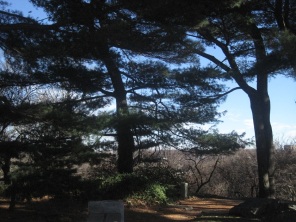 At the top of Bussey Bill, overlooking the Blue Hills in one direction and downtown Boston in another I sat for a while, meditating under the white pines. Tossed in the wind on a clear cold day they reminded me lines from an e. e. cummings poem “tne leaping greenly spirits of tree and a blue true dream of sky. A couple of weeks before coming here, Robin and I began going to a meditation session with followers of Thich Nhat Han. Off and on over the years I’ve practiced meditation, but never with a group before. I’m not a Buddhist, but I find Buddhism attractive in its focus on peace and compassion. A group that also practices in the way of Thich Nhat Han meets on Thursday evenings at the church across the street from David’s place. So I went there last week and will go again next week if I can.
At the top of Bussey Bill, overlooking the Blue Hills in one direction and downtown Boston in another I sat for a while, meditating under the white pines. Tossed in the wind on a clear cold day they reminded me lines from an e. e. cummings poem “tne leaping greenly spirits of tree and a blue true dream of sky. A couple of weeks before coming here, Robin and I began going to a meditation session with followers of Thich Nhat Han. Off and on over the years I’ve practiced meditation, but never with a group before. I’m not a Buddhist, but I find Buddhism attractive in its focus on peace and compassion. A group that also practices in the way of Thich Nhat Han meets on Thursday evenings at the church across the street from David’s place. So I went there last week and will go again next week if I can.
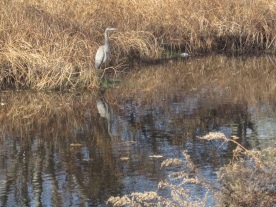 On one of the ponds in the Arboretum at the bottom of the hill I saw a great blue heron. There was a heron that used to hang out in one of the other small ponds, but I’ve never seen one in that particular pond before and never seen one this late in the year. It was cold and windy, but the heron stood there watching and waiting. A couple of times I thought it would fly, but it just stretched its wings a bit and went on watching and waiting.
On one of the ponds in the Arboretum at the bottom of the hill I saw a great blue heron. There was a heron that used to hang out in one of the other small ponds, but I’ve never seen one in that particular pond before and never seen one this late in the year. It was cold and windy, but the heron stood there watching and waiting. A couple of times I thought it would fly, but it just stretched its wings a bit and went on watching and waiting.
Near the main entrance, I saw a very large stump of a recently cut down tree. I think it was one of the several dawn redwoods near that gate. Bits of wood from the tree on the ground were surprisingly light like balsa wood. Wonder why it was taken down. The dawn redwood (actually deciduous) is the state fossil of Oregon. Many fossil remnants have been found in the John Day Fossil Beds. The dawn redwood was once thought to be extinct, but a grove was found in China in the 1940s and several have been planted in the US, including one on the Capitol grounds in Salem.
Thankful to be able to come back to these familiar places.
The North Fork of the Santiam River – and Other Places by the Water
Friday I went with some friends to the North Fork of the Santiam River, east of Salem, in the foothills of the Cascades. Beautiful spot, but the steep slope down to the river was quite a challenge for me. So when the others started climbing a huge rock outcrop to get over to a swimming hole, I balked. They tried to talk me into it, but finally I convinced them I’d be fine sitting by the water while they swam. I don’t mind solitude and I’ve been drawn to water, ever since I was a child.
When I was very small we lived in the Merrymount neighborhood of Quincy, Massachusetts. Merrymount had a little scrap of urban beach on the outskirts of Boston Harbor where my dad took me walking and taught me to skip stones over the water. Some years later, my grandmother bought a summer house in Hyannis on Cape Cod and we time-shared the place with various aunts, uncles and cousins. My dad and I would go walking to the end of the public beach, down to the jetty that marked the entrance to Hyannis Harbor. My dad was a quiet man, not much given to talking. We’d sit on the rocks watching the water and the boats, the seagulls and the sky.
Often, I would go there by myself. One time I remember clearly, my dad was sitting about halfway down the beach. I don’t remember why, some mood, some teenage thing, but I wanted to be alone. I said, Hi, and kept on walking to the jetty. From there I turned and saw him, wondering if I’d broken something that we shared. He died when I was 20 and after he died, I put that image in a poem: the changes I was going through, his shirt bright against the sand, white as a sail in the morning. I’m writing this on his birthday. He was born August 18, 1909.
The college I went to, Regis College in Weston, MA, is on the edge of the Weston town forest. I used to go down through an abandoned orchard, through the woods to a small brook and sit for hours. Often I had a book with me, maybe something I was supposed to study, more likely my well-worn paperback anthology of American poetry or a slim copy of e.e. cummings poems, losing myself in thought under the “leaping greenly spirits of trees and a blue true dream of sky.”
Growing up, I said I would never live inland; always wanted to be near the ocean. As long as I knew where the water was, I was oriented. But, for over two decades in the 1970 and 1980s I lived in Louisville, Kentucky. Never did recapture that sure sense of direction. It took a long time, but eventually I found my way to a place on the banks of the Ohio River that I kept going back to. Not so much wild as neglected, a bit of undeveloped land on a bend of the river below the Falls of the Ohio between the dam and hydro-electric plant and the McAlpine Locks. I liked the juxtaposition of the natural and the human working environment. Fascinating to watch the tows – three long and two abreast – maneuver into the locks with inches to spare, and then see the water rise or fall.
 Then I’d go down to the riverbank and sit on a rock or fallen log. Sometimes there would be a few guys fishing, or someone taking a walk. Often just me and the ducks in the water. In spring sometimes, some of the trees on the riverbank would be below the high water mark, seeming to float above their own reflections.
Then I’d go down to the riverbank and sit on a rock or fallen log. Sometimes there would be a few guys fishing, or someone taking a walk. Often just me and the ducks in the water. In spring sometimes, some of the trees on the riverbank would be below the high water mark, seeming to float above their own reflections.
In summertime, with the river low, the dried out mud would crack. Down by the power plant, and across the river on the Indiana side, driftwood piled up. Now and then I’d take some home. I hauled them around with me from place to place whenever I moved and still have some of the lighter pieces here in Salem. But the best one, the section of a hollowed out stump that I had to ask my son to carry from the riverbank to the car for me, I left back east in the community garden in Brookline, MA where I volunteered.
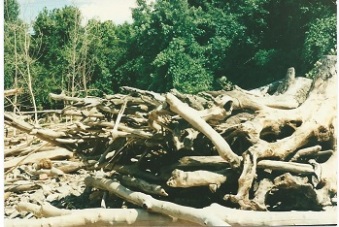
When I moved back to Massachusetts from Kentucky in 1991, I lived for a couple of years in Cambridge a few blocks from the Charles River. Years later I worked in Cambridge and I’ve spent a lot of time biking along or hanging out by the Charles; and often times I’d go biking by the ocean. When I moved to the Jamaica Plain neighborhood of Boston, I found a place by Bussey Brook at the foot of Hemlock Hill in the Arnold Arboretum that I gravitated to. I went there often, in all seasons, to sit and think, sometimes to practice T’ai Chi.
Eastern hemlocks line the banks of the brook and climb the stony hill, graceful branches sweeping toward the ground. Hemlocks all over the east coast are under attack by an infestation of a tiny insect, the hemlock wooly adelgid. Hemlock Hill is thinning out. The Arboretum staff selectively treated some trees, but can’t save the bulk of them. Since the Arboretum is a collaboration between the Boston Parks Department and Harvard University, Harvard is studying the fate of Hemlock Hill. Already, other trees are filling in the gaps.
Here in Salem, we have the Willamette River. If I’m downtown at a meeting or doing errands, I might bike through Riverfront Park and sit by the river for a while. I often see large birds, sometimes one sometimes two or three that soar above the river. I wish they’d be eagles, but probably they’re hawks – hawks can handle the city. My daughter and I sometimes go walking in Minto-Brown Island Park, and there’s a spot she likes, but I haven’t yet found that place I’d gravitate to, over and over again, that place to sit and be, lost in thought, watching the water, the trees and the sky.
So the hours I spent Friday on the North Fork of the Santiam River were good for the soul. Thank you, Peter who invited us and got there first, and Bobbie who drove, and Gary who knew where the trail to the riverbed was; thanks for letting me sit by the water and thanks for the camaraderie later on.
Terry Garcia – Road Trip Memories
Terry Garcia – 8/10/12 – Dungeness Wildlife Refuge
My sister Terry used to say we did not grow up in the same house because either we did not remember the same things or we remembered the same things differently. As adults, shared experiences became even fewer. We each moved to various places around the country and developed divergent interests. However, during most of the 1990s we were both living in eastern Massachusetts again, where we grew up; and more recently we both lived in the Pacific Northwest. So, in later years we were able to experience some of the things we did share: we both liked flowers and we both liked to go places and see things. We had some memorable road trips, sometimes with flowers, and oddly enough, sometimes with glass.
In 1991, the year I moved back to Massachusetts from Kentucky, my life was a mess – I’d been laid off and my daughter, who was starting her junior year at the University of Wisconsin/Madison, wound up in the hospital shortly after the semester began. Terry took her vacation time, which she had planned to use exploring a move to the west coast, to take me to Madison to check on my daughter. On the way back to Boston we traveled through the southern tier of New York State on Rt. 17 (before it was incorporated into I-86). Rt. 17 was a peaceful, low traffic road through rolling farmland and small towns.
I don’t remember what drew us to stop in Corning to tour the Corning glass works, maybe a billboard, maybe something in a guidebook. Anyway, we did stop. Of course, there was much marketing of Corning glass products from ordinary cookware to high tech glass for specialized uses, but there was also a fascinating museum of glass artifacts, some dating back to ancient times. Who knew that the Romans had souvenir goblets engraved with the names of famous gladiators? In those days Corning also owned the now defunct art glass firm, Steuben Glass. We watched from a gallery as glass makers, ordinary looking guys in shorts and muscle shirts, pulled gobs of molten glass and blew and turned and ground and polished it into intricate (and expensive) designs.
Years later, when I could afford a small piece of Steuben glass, I gave Terry a scallop shell as a token of thanks for taking that trip with me at a very difficult time in my life. I knew Terry would have remembered that, as kids, we collected scallop shells and quahog shells and other shells at the beach. But did she remember, I wonder, the time we buried a bunch of shells in our backyard in West Quincy, MA, on a hill about four or five miles inland, hoping to confuse some archeologist in the far, far future?
Terry and my daughter and I once took a day trip to the White Mountains in New Hampshire where the Old Man of the Mountain, the Great Stone Face, gazed out over the terrain before it collapsed. We stopped on the way back at the outlet mall in Kittery, ME. There was another, spur of the moment, trip Terry and I took to New Hampshire, to the state liquor store just over the state line, to buy some mega-million lottery tickets that weren’t available in Massachusetts. Terry loved to gamble, always hoping for that lucky strike. I don’t gamble much, but I was always up for a road trip.
Terry never expected to stay permanently in Massachusetts. For a while she wasn’t sure where she wanted to go and decided to explore the Research Triangle in North Carolina. So one year in mid-March, still winter in the Boston area, we headed south chasing spring. The farther south we went (eventually as far as Myrtle Beach, SC), the warmer and greener it got.
Meandering through the university campuses in the Raleigh-Durham-Chapel Hill, NC area, we came across the Duke Gardens where spring-flowering trees were in full bloom. I’d never seen a weeping cherry tree before, blossoms cascading to the ground on graceful strands. Since I had lived in Louisville, KY, for many years, I knew how spectacular spring could be in the South. Terry said she would never have believed it if she hadn’t seen it for herself.
On the way back to Massachusetts Terry (reluctantly) indulged my request to go well out of our way to see Kitty Hawk, NC where the Wright Brothers flew the first airplane. Desolate place on a gray and dreary day. One restaurant open in the off season, not much else there at all except nondescript summer houses perched precariously on the windswept beach.
The Pacific Northwest kept calling Terry, who had lived for many years in Alaska and a few in California. So In 1998, with help from my son David, we loaded her things on a rental truck and she and I went west, driving that truck almost non-stop, heading for my daughter Robin’s place north of Seattle, not far from Bellingham where Terry soon found an apartment. (This cross-country trip was the only time I ever remember doing any of the driving on one of our road trips.) Most of that trip is a blur; I do remember getting lost trying to find a gas station off the Interstate in western Connecticut at night.
Ferns and forest in the Pacific Northwest
Montana provided the most vivid memories, traveling on I-94 through the tall grass prairie in the east and 1-90 in the mountains to the west. Early one morning in eastern Montana we stopped at a rest area on a bluff overlooking the Yellowstone River. The sun was rising though a light haze and it turned the very air to gold. I took picture after picture only to realize I was out of film. But I’ll never forget that golden mist, or the view down to a bend in the Yellowstone. Down the road, we got off the highway to buy gas in the tiny town of Hysham, MT. The gas pumps were at the far end of town at the Friendly Corner Store. We got Friendly Corner travel mugs. I lost mine, but Terry held on to hers. Late in the afternoon, in the western Montana mountains, stopping to eat in Missoula, we saw a rainbow over the town.
A few years later I found my notes from this trip. I wrote them up as Terry & Laurie’s Excellent Adventure and sent a copy to her. Two years ago, when I moved to Oregon, my son drove me across country in his Prius. I was determined to find the rest area overlooking the Yellowstone and the Friendly Corner Store. We found both. No golden haze, no more coffee mugs – but we saw the bend in the Yellowstone and I bought some Friendly Corner candles and sent one to Terry.
After Terry got back with Nick, they lived for a while in Palm Desert, CA. I visited them there early one summer and one day Terry and I escaped into the mountains from the heat of the valley floor. We had seen a notice about an open studios event in an artist colony in a little town whose name I don’t remember. The ticket to the studios was a small ceramic tray made by a potter in the town. I still have mine, and now hers too. Another day, we went to San Diego to see the pandas at the zoo.
The Pacific Northwest kept on calling, and Terry and Nick moved to Lynden, WA, a small town on the Canadian border, surrounded by dairy farms and berry farms, tucked between the North Cascades and the Salish Sea – with a casino to boot. Every day, Terry told me, on her way to work in Bellingham she looked for the eagle that liked to perch on a telephone pole. Her commute took her by some spectacular views like this one.
A few months after Nick died, my daughter, now living in Oregon, and I went to visit Terry. We took the ferry one day to Butchart Gardens near Victoria, BC on Vancouver Island. It was summer and the gardens were full of flowers in bloom. Terry sent me some of her photos from Butchart Gardens, including this beautiful one she took overlooking the formal garden.
The next day we went to Vancouver, BC to the Capilano Suspension Bridge. I crossed the bridge, Terry and Robin didn’t. Terry started out, but some bratty teenagers were jumping around, causing the bridge to sway.
The last time I saw Terry before she died last winter was August 13, 2012, a year ago today. I went to Lynden for a long weekend and Terry took me on a whirlwind tour of Northwest Washington. One day we took the Port Townsend ferry to the Olympic Peninsula and went to the Dungeness National Wildlife Refuge at Sequim, WA. Terry wanted to show me this beautiful place she had found a few weeks earlier when she went to the Peninsula for the lavender festival. There was lavender still in bloom everywhere, in fields and yards, on the way to the Wildlife Refuge. At the Refuge we walked down a forest trail to a driftwood-strewn beach on the Strait of Juan de Fuca. It was foggy down by the water and Terry was disappointed not to see across the Strait, but I liked the fog drifting through the trees and over the water. That’s where I took the photo of Terry waving on the beach at the top. Later the fog cleared and from a waterfront restaurant in Port Angeles, we did see across the Strait to Canada.
The next day we went to Chihuly Garden and Glass, a permanent exhibit of glass art under the Space Needle at Seattle Center – a gift to his home city from famed glass artist Dale Chihuly. This is a fantasia of colors and shapes, room after room, indoors and out, all in glass.
On the last full day of my visit, we went to the annual open house at Pilchuck Glass School in a rural part of Stanwood WA. Dale Chihuly was also involved in establishing Pilchuck as a place for glass artists and students to come together to learn and create. The open house showcased an amazing variety of art glass techniques. We finished with a late lunch in the pretty town of LaConner overlooking the Swinomish Channel. On the Swinomish Reservation on the opposite bank a group of Native Americans were having a festival with canoe races in the channel.
Terry in LaConnor 8/12/12
Early the next morning, one year ago today, Terry dropped me off at the train station in Bellingham. That was the end of our last road trip together.
Bicycling was another thing we shared – for a while when we both lived in Massachusetts in the 1990s. Terry started biking with some co-workers at the Pilgrim nuclear power plant in Plymouth, MA where she worked for several years keeping maintenance records in order (kind of important considering this is a nuclear power plant). She invited me to go biking with her sometimes. Until I got my own bike, I rode one of my son’s bikes. Terry and I biked in Cambridge on Memorial Drive which is closed to motor vehicles on summer Sundays, at the Arnold Arboretum in Jamaica Plain, on the Cape Cod Rail Trail, and on the bike path along the Cape Cod Canal, where she posed for this photo with a helmet mask.
Eventually, Terry lost interest in bicycling, but it transformed my life and I am still an avid cyclist – that’s for other stories on other days. But I just want to say that cycling was a great gift my sister Terry gave me. I brought her old Trek hybrid – still with the name plate of a bike shop in Quincy, MA, still in great condition – back to Oregon for a friend of mine who bikes everywhere, but whose own bike was heavy, hard to ride and in bad shape. My friend calls the Trek Black Beauty and it pleases me that it’s in good hands.
Another thing Terry and I shared: intolerance of bigotry. During her years in Alaska, Terry gained a particular affinity for Native American peoples. When I visited her in Palm Desert, CA, she told me about a poster she had once seen in the office of one of the casinos there, where she worked for a while. The poster had the Native American Ten Commandments. She asked at the office, but couldn’t find the poster again. Later I searched online and found more than one version. I sent a couple of them to her superimposed on photos I took while I was there. This is the one she hung on a wall.
Rest in Peace, Terry. I hope you remembered our road trips as vividly and as fondly as I do.
Summer Heat PDX 7/27/13
This amazing photo (by Adam Elliott for Portland Rising Tide) was taken at the Summer Heat PDX action on 7/27/13 in Vancouver, WA, one of many actions around the country called by 350.org to highlight fossil fuel hot spots. The Pacific NW organizing partner was Portland Rising Tide which did a fantastic job putting together such a creative and inspiring action. So glad I went.
Even before I moved to Oregon nearly two years ago, I knew that coal companies planned to transport up to 150 million metric tons of coal by rail (or rail to barge) through Washington and Oregon to terminals on the coast for export to Asia. I was shocked – and still am angry and saddened – to think that this beautiful region with so much history of innovative environmental policy and green energy development could become a coal transport corridor. Potentially dozens of coal trains a day, each well over a mile long, would travel down the Columbia River and through Washington or Oregon to the coast, spilling coal dust all the way.
Coal is toxic in so many ways to climate, land, air and water. Coal is toxic at every stage – extraction, waste, transport & combustion. I spent months looking for people who were working against coal export and went to events in Eugene and Portland to support them and learn from them; so I was really glad when the Sierra Club Beyond Coal Campaign http://content.sierraclub.org/coal/ set up a group in Salem https://www.facebook.com/pages/Salem-Beyond-Coal-Campaign/268073759984734 .
Now, with the boom in fracked oil from North Dakota, oil companies are expanding shipments of oil by rail and want to vastly expand capacity in ports and refineries on the Pacific NW coast. It’s illegal to export US-produced oil, but oil companies are lobbying hard to change that law. One of the largest proposals is for an oil terminal in the Port of Vancouver, WA on the Columbia River. The Sightline Institute has a report on the Northwest’s Pipeline on Rails. http://daily.sightline.org/2013/06/24/the-northwests-pipeline-on-rails/ . Scary for the climate and scary for communities along the transport corridor, especially in light of the recent tragic oil train accident in Lac Megantic, Quebec. At Summer Heat PDX I talked with the head of ILWU Local 4 which opposes the oil port in Vancouver. It’s too dangerous,” he said, “a freak accident could shut down the whole river.”
I’m not as familiar with the LNG export issue, but so much natural gas produced in the US is produced by fracking, expanding transmission and export capacity is likely to do a lot of harm. And natural gas is still a fossil fuel. Not as bad as coal, but building up natural gas infrastructure just postpones the transition to a renewable energy economy.
The coal and oil will all come on the BNSF Rail Road, following the Columbia River and on through Washington and maybe some of Oregon. The LNG pipeline would cross the river. So yesterday hundreds of us from the Pacific NW drew a symbolic line across the Columbia River. From the riverbank in Vancouver, WA dozens of people put small boats in the water and hundreds more (including me) walked onto the I-5 bridge that spans the river between Oregon and Washington.
If these proposals are approved and we need to draw a line that’s more than just symbolic, I think I’m ready to take that step. Protesters in Utah stopped construction for a day at the first tar sands oil extraction being built in the magnificent canyon lands of southwest Utah. In another Summer Heat event in Somerset, MA protesters gathered at one of the biggest, worst coal fired power plants in the northeast and called on the Governor to close Brayton Point. 44 people were arrested in an act of non-violent civil disobedience. If I still lived in Massachusetts, I hope I would have been one of them.
(Here’s a link to my article about Summer Heat PDX in Salem Weekly: http://www.willamettelive.com/2013/news/coal-oil-gas-none-shall-pass/ )
Fossil Fuel on the BNSF Hi Line
Oil Coal Gas – None Shall Pass. That was on the banner hung over the Columbia River from the I-5 Bridge during the Summer Heat PDX rally on 7/27/13 (see my next post on Summer Heat PDX). But some already does pass. It’s very evident along the rail lines which already carry coal and oil. Plans are to increase that transport through the Pacific Northwest by over a hundred million tons of coal and hundreds of millions of barrels of oil – annually.
I often travel by train. I’ve been across country by train several times including last fall to visit my son in Boston; and went by train to the Bellingham area several times earlier this year. On both these routes, Amtrak travels on BNSF track. From the Pacific Northwest to Chicago there are coal trains all along the BNSF Hi Line through the northernmost states. Most of the coal goes east from the Powder River Basin in Wyoming and Montana to industries and coal-fired power plants in the Midwest. But some goes west through the Columbia River Gorge to the power plant in Boardman, Oregon or up through Washington, along Puget Sound to coal export terminals in British Columbia. If the coal export proposals for Oregon and Washington are approved, millions more tons of coal a year will come through the Columbia River gorge on trains over a mile long on the way to Pacific Northwest ports.
The BNSF Hi Line also passes through the heart of the Bakken oil fields in North Dakota and has hundreds of oil tanker cars in play – on the tracks, on sidings and in rail yards. When I went to Boston last fall, on the eastbound trip at night, gas flaring off the wells shimmered eerily in the empty darkness. Oil workers got on the train in Williston, ND going home or somewhere for their week off shift. Young roughnecks moving through the train, looking for the bar, bragging on the money they’re making. Got into an argument with one slick young man in khakis who didn’t work in the oil fields, but did business with them. Next morning met an older guy, late 40s maybe, on his way to his daughter’s place in Minneapolis for his week off after working two weeks on. Hard way to make a living for someone his age. Brutally cold in winter, brutally hot in summer, relentless wind vast prairie.
Also met an older couple from Williston who talked about how crazy things have gotten in their small town, now busting at the seams with oil workers. Housing prices are through the roof, their kids can’t afford to stay in the area where they grew up. Guys are living like students several to a house, in temporary barracks-like compounds, and in motels.
Experienced both the oil and the coal when I moved to Oregon two years ago, driving out here with my son David in his Prius with my two cats in a cage in the back of the car. Looking for a place to spend the night, we couldn’t find a vacancy anywhere along I-94 in western North Dakota. When we finally found a place in Miles City, MT the desk clerk told us that ND motels were full up because of the oil boom. David and I also saw coal trains on that trip, including the one in the photo at the top taken from a rest area on a bluff in eastern Montana overlooking a bend in the Yellowstone River.
July 30, 2013
68 years old today. Don’t really know what to make of that except that I’m glad to be still here. Starting to think about turning 70 in two years & would like to do something memorable then. Not sure what. Not so much into planning as being receptive to whatever meaningful and interesting occasion comes up. Although – biking around Crater Lake is appealing. It’s supposed to be one of the all-time great bicycling experiences. Not really a long ride but evidently lots of climbing. I’m not in any shape to do it now, but could be then if I decide to do it.
On my 60th birthday I biked halfway around Mt. Hood from Welches to Hood River plus a short loop on the bike path through the Mosier Tunnels. That was a memorable day – a true convergence. Summit to Surf, a fundraising ride for the American Diabetes Association. Since David is diabetic I had done several ADA rides in New England and since Robin was living in Oregon I had wanted to do this ride in Oregon for quite a while and there it was on the very day of my 60th birthday.
I love Mt. Hood – the presiding presence of Mt. Hood. I look for it every time I’m anywhere near Portland. Ocasionally on a good day I can even see it from Salem.
I spent a week or so with Robin and then we rented a cabin on the mountain for a couple of days. David came out. We all went to Timberline Lodge the day before for brunch and then to the Warm Springs Reservation. They have a great museum of Native American history and culture and we went briefly to the casino.
The bike ride was hard but fantastic. Beautiful weather. Started very early to catch the cool of the morning. It did get hot by the end. I did 65 miles give or take – met my goal to ride at least 60 miles.
So Crater Lake at 70? Maybe. We’ll see what else comes up. Right now, Robin is taking me out for Thai food and incredible cake from Konditorei! A Happy birthday indeed.
Sunrise on Mt. Hood 7/30/2005
July 15, 2013. Happy Birthday, David!
My son, firstborn of two children, is 44 years old today. Always a bit ahead of those developmental stages so earnestly described in parenting books, from the start David challenged me to grow, to keep up with his energy, his questions, his ever logical line of argument. In countless ways, big and small, David has been there for me and with me. Trips to the grocery store on Friday nights after work; going out for breakfast on weekend mornings; helping me buy the Trusty Trek hybrid bicycle that changed my life and stays at his place to ride when I go back east to visit.
There was 1991, the year when everything went wrong and I moved 1,000 miles from Louisville, Kentucky back to Massachusetts. David took leave from the Coast Guard, flew in from California, threw all my stuff in a rental truck and we drove off towing my little red car. Somehow, even though that was the year from hell, that trip was time out of time, carving out its own space to enjoy the scenery, the rhythm of the road, and each other’s company.
There was that other cross country road trip nearly two years ago, when David moved me from Massachusetts to Oregon with my two cats in a cage in the back of his Prius. Bittersweet, that trip, seeing the vast and beautiful country, enjoying the time together, knowing that at the end we would be a continent apart. For years I made the trip from Massachusetts to Oregon to visit my daughter. Now that I’m here, I make the same trip in reverse to visit David.
In 2010, to celebrate our July birthdays, David and I went to Maine. I biked around Cape Elizabeth while he hung out in Portland and on the beach. Before winding up with dinner in Portland, we met at Portland Head Light. Once a Coastie, David has a fondness for lighthouses. Portland Head Light sits on a craggy outcrop overlooking the ship channel at the entrance to Portland Harbor. One of the most beautiful and iconic lighthouses in the country, Portland Head Light is also one of our many wonderful shared memories.
Happy Birthday, David. I love you. Live long and prosper.
4th of July 2013.
Some other 4th of July over 50 years ago, my cousin Elaine and I stayed out all day on Kalmus Park Beach, the town beach a block or so from our grandmother’s summer house in Hyannis on Cape Cod. What I remember about that day is later, watching fireworks from the same beach, suffering the wicked heat of a wicked sunburn radiating back on my legs from the long pants put on in the cool of the evening. The 4th of July, back before global warming kicked in, before we knew about the ozone layer, was the real start of summer – sun and sand and salt water.
In eastern Massachusetts we were deep in stars and stripes country, where it all began. Plymouth Rock and Paul Revere’s ride and the shot heard ‘round the world. I grew up in Quincy, MA, home of John Adams, John Quincy Adams and John Hancock; many other founding fathers once lived nearby. They held their meetings just up the road in Boston’s halls and taverns and dumped their tea from a wharf in the inner harbor. My high school boyfriend lived on the hill in Quincy where Abigail Adams watched the battle of Bunker Hill on the far side of Boston – she wrote about it in letters to her husband John, so often away making the Revolution and the new nation.
Some other year, a decade or so ago, after moving back to eastern Massachusetts after many years away, on another wicked hot 4th of July, on the spur of the moment I went on a whale watch, to escape the heat, to be out on the water, to see those magnificent creatures. I did this again on other July 4ths. If I took the morning boat, I’d see Old Ironsides, the USS Constitution, the oldest commissioned ship in the US Navy, on her annual, obligatory, 4th of July turn around Boston Harbor. One magic day, I think it too was on a 4th of July, out on Stellwagen Bank, a pair of whales played around the boat so close I felt the spray from a blowhole; they swam around and under us for half an hour or so. The captain had to cut the engine – we were out there at the pleasure of the whales.
In the years between the beaches of my childhood and the days of watching whales, the 4th of July became complicated. The land of the free and home of the brave was also the land of Jim Crow, bombs in a church in Birmingham and bombs in Vietnam. Marching on Washington, in Central Park, protesting war and injustice in big East Coast cities and small Kentucky towns, “Go back to Russia”, we were told. “America – love it or leave it.” Patriotism hardened into an all or nothing thing, brooking no criticism of the good ol’ USA. Back in the day, you either waved the flag or you didn’t, and I didn’t. Still don’t. Don’t pledge allegiance to it either. Flags belong in government buildings, marks of official business. Flag waving as some kind of loyalty test smacks of jingoism and intolerance.
But I still am moved by the ideals that America proclaims, of liberty and justice for all; that we the people, all of us were created equal with unalienable rights to life, liberty and the pursuit of happiness. It’s the living up to those ideals that really matters. And, as I have grown to understand, it matters greatly that we live in such a way that future generations will have the resources and social structures to pursue those same ideals.
Already it’s after midnight, no longer the 4th of July, but I want to end with this video statement by Van Jones that captures the spirit of the day:
http://www.upworthy.com/happy-4th-of-july-heres-a-reminder-of-what-america-is-all-about?c=utw1
Nocturnal Introduction
I’ve spent so much time commenting on other people’s blogs, my son keeps telling me to write my own. I actually have bits and pieces done in fits and starts and tucked away in various digital folders but this is the first real post and it will be very short because it’s very late. It took a while rummaging through old photos to find the one I wanted and another while to find a theme that would work with it. Now that I’ve started this blog, will I keep it up? We’ll see.



